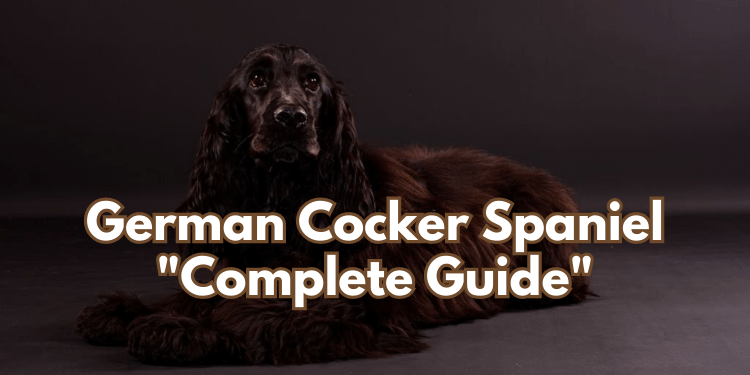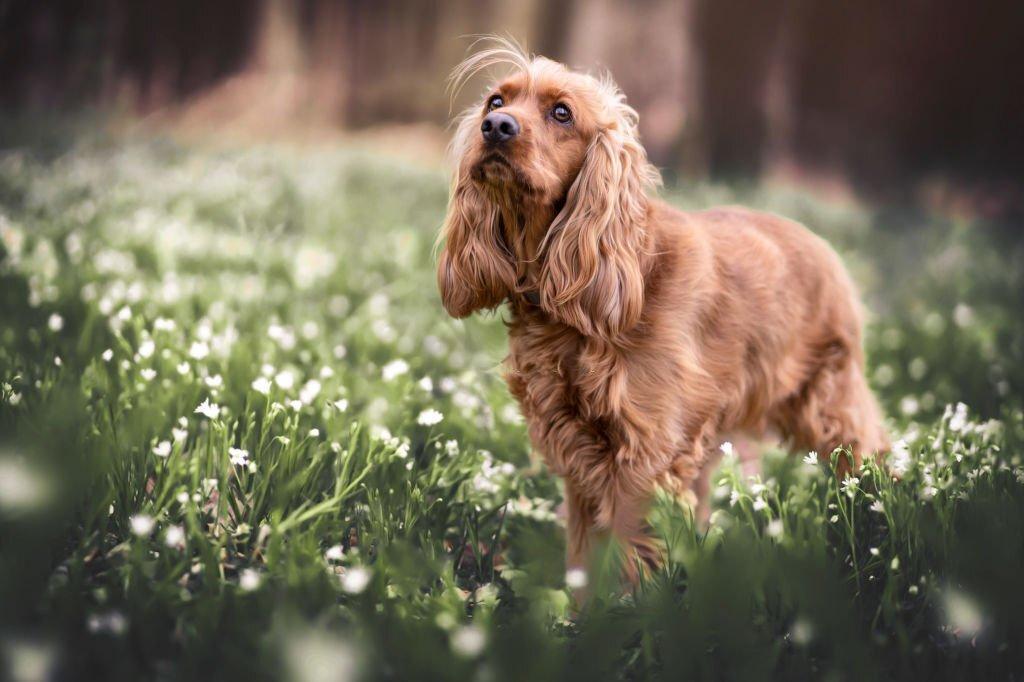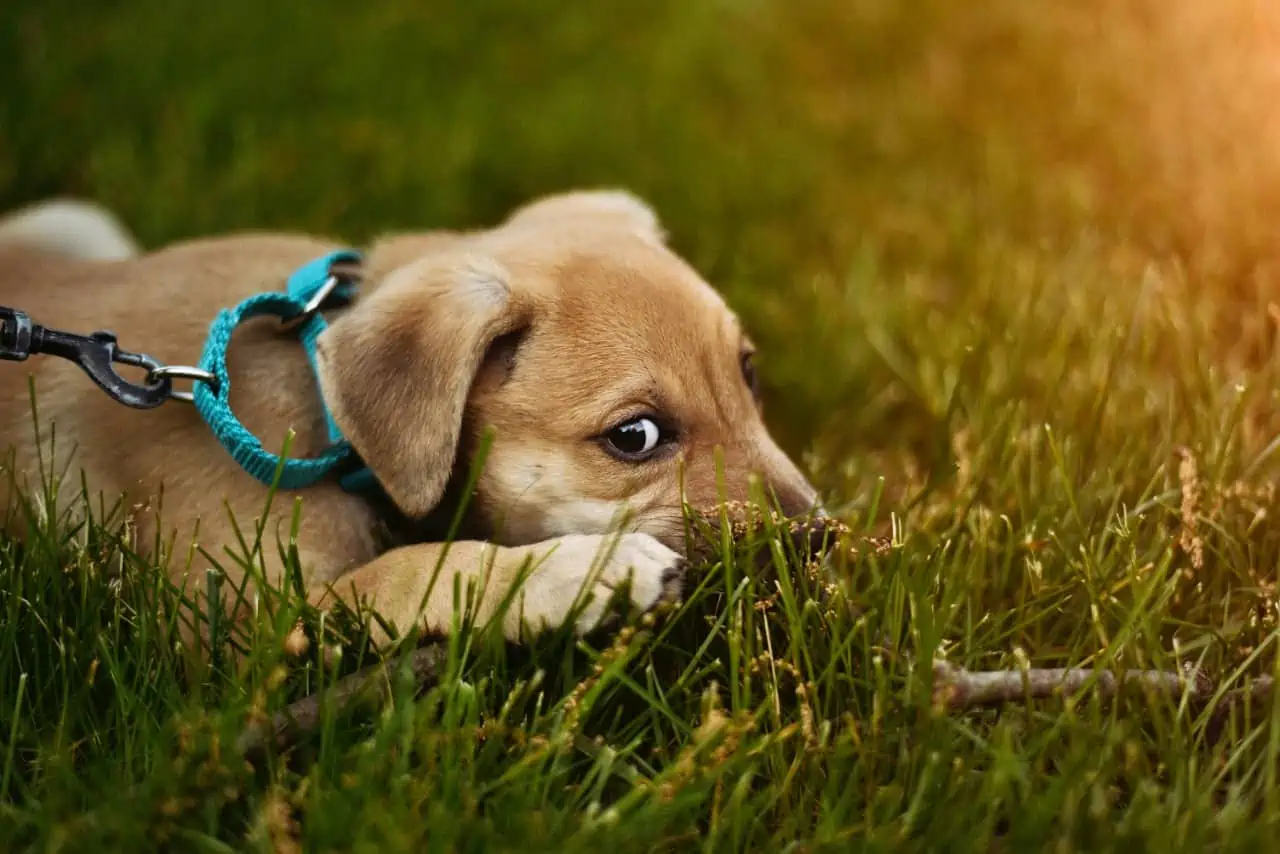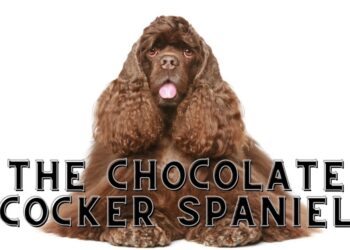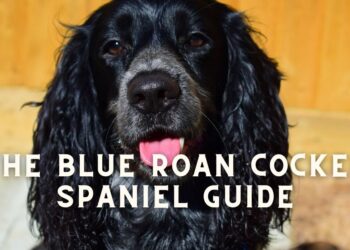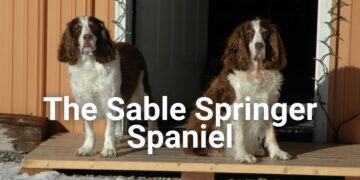The German Cocker Spaniel, a breed renowned for its versatility and charm, has captured the hearts of many dog lovers around the world. Originating from Germany, this breed is not just an endearing family companion but also showcases intelligence and agility. Delve into this article to uncover the intriguing nuances and quintessential traits of the German Cocker Spaniel.
Table of Contents
Physical Characteristics of German Spaniel
The German Spaniel is a well-muscled and medium-sized dog.
Size and weight
The male German Spaniel exhibits a height range of 19 to 21 inches, spanning from 40 to 55 pounds. Similarly, the female counterpart presents a height variation of 18 to 20 inches, maintaining a weight range of 40 to 55 pounds.
According to some research, here is some data according to their monthly growth.
6 MONTHS: Height: 17.0 inches Weight: 21.5 lbs(male)
Height: 16.0 inches Weight: 21.5 kg (female)
12 MONTHS: Height: 18.5 inches Weight: 37.5 lbs(male)
Height: 17.5 inches Weight: 37.5 kg (female)
18 MONTHS: Height: 20.0 inches Weight: 47.5 lbs(male)
Height: 19.0 inches Weight: 47.5 kg (female)
Coat and colors
This breed displays a distinctive coat composition. The fur is short and fine around the head, gradually transitioning to a longer length across the body. The coat is characterized by a thick and wavy texture, imparting a somewhat coarse tactile feel.
Furthermore, a moderate undercoat offers protection during ventures through dense vegetation. The German Spaniel showcases diverse colors, including fawn, liver, white, red, brown, and gray.
Facial features and tail
With medium-long ears extending halfway to the nose, the German Spaniel boasts a unique look. Its proportions align with a 2:1 length to height ratio, distinguishing it from other spaniel breeds. The nose color ranges from black to brown, matching the coat. Dark brown, alert eyes define its expression. The breed’s signature coat features short hair on the head and longer hair on the body, exemplifying its distinct physical traits.
Temperament and Personality
The German Spaniel is known for its versatility and intelligence, but it is a working gundog, companion, and family pet.
Natural disposition
These pups epitomize liveliness, adaptability, and friendliness, seamlessly integrating into any household. Their exuberant nature and versatile demeanor make them an ideal fit for families of all kinds. With an innate charm, they quickly win hearts and establish themselves as cherished companions. Their delightful disposition is perfectly complemented by their enthusiasm for play and outdoor activities, aligning perfectly with familial dynamics.
Interaction with children and other pets
With the kids they grow up with, they’re like peas in a pod. But with new little humans, they might play the waiting game at first. Once they warm up, though, they can be a whirlwind of energy sometimes a bit much for tiny tots. They have a stubborn streak and look for a firm hand in leadership.
History and Origins
Ancient roots and early
The origins of the German Spaniel can be traced back to the Stober Dog, a venerable breed with a history dating back to the 1600s, a significant period predating the tumultuous times of the German Revolution. During this era, the aristocratic elite played a pivotal role in refining the capabilities of the Stober Dog, shaping it into a proficient pointing and flushing dog for hunting game. These dogs exhibited a remarkable talent for assisting hunters in locating and retrieving game birds.
Following the upheavals of the German Revolution, there was a democratization of dog ownership, with commoners enthusiastically embracing the Stober Dog as their choice of hunting companion. However, the financial constraints of the common folk sparked a desire for a more versatile solution that could fulfill multiple hunting roles effectively. This marked the inception of the German Spaniel, a breed conceived to meet the demands of a broader audience.
Development in Germany
In 1903, the Deutscher Wachtelhund was recognised as a breed and, following that, the German breed club, the Verein für Deutsche Wachtelhund (VDW), was organized. The term Stoeberer has since become a category of hunting dog in Germany, with the Wachtelhund being the sole member of that category.In 1910, the VDW selected four male dogs and seven female dogs upon which to base the breed standard for the Wachtelhund.
Recognition by kennel clubs
In the 1960s and 70s, several German Spaniels were imported into the United States, and descendants of those dogs are now used in Canada to track down and flush out American black bears. A further pair of dogs was brought to the United States in 1994, and the United Kennel Club recognised the breed in 1996, placing it in the Gun dog group. There are thought to be about 100 German Spaniels in North America.
Health and Lifespan
These pups are generally in good shape, and breeders have nailed it in terms of keeping them healthy. But, you know, there’s always a little something to watch out for. So, you’ve got these hip and elbow things called dysplasia.
It’s basically when the joints don’t quite fit right due to genetics, but no worries this isn’t something you’ll see every day with German Spaniels. Thanks to some intelligent breeding, it’s not a significant issue. And if it does pop up, a balanced diet with those excellent healthy oils and early spotting can help manage it.
Then there’s the kneecap party trick, also known as patellar luxation. Sometimes, the kneecap decides to go solo and slips out of the joint, causing a stir. It’s not the most common thing, but knowing it is good. This little caper can bring discomfort and might cozy up with arthritis if not dealt with.
Like seizures that drop in occasionally, not super frequent, but they can come in all shapes and sizes. It’s like the Spaniel version of a rollercoaster, with varying intensity levels.
Common health concerns
Be aware of potential elbow dysplasia, skin infections, and ear infections as common health issues. Also, pet parents need to focus on the following:
- Obesity
- Bloat
- Skin allergies
Life expectancy
The lifespan of the German Spaniel is about 12 to 14 years. To increase your German Spaniel’s lifespan, feed them a healthy, high quality diet formulated for large breed dogs or try a formula for active breeds.
Grooming and Care
Coat care and grooming requirements
Maintaining the pristine appearance of your German Spaniel’s coat requires consistent effort, as this breed is not hypoallergenic. A weekly brushing routine is essential to preserving the coat’s quality. Employ a pin brush and a metal comb to manage the skin effectively. When encountering tangles, approach them patiently, utilizing a de-tangling spray when necessary.
Regular trims are essential to stop gunk buildup and keep your buddy comfy. Frequent brushing serves a dual purpose: it curbs shedding and promotes the overall cleanliness of your German Spaniel. Particularly during warm seasons, inspecting fleas meticulously and ticks daily is advisable.
Bathing and nail trimming
The German Spaniel typically doesn’t require frequent bathing—only a few times annually will suffice. Before bathing, diligently address any mats in the coat by combing or carefully cutting them out. Thoroughly rinse the skin to prevent soap residue, which can attract dirt.
A bathing schedule of approximately every three months, with a mild shampoo, is recommended. However, a dry shampoo can be an interim solution if your German Spaniel develops a noticeable odor between baths. Given potential skin sensitivities, consulting your veterinarian for the most suitable shampoo is wise. Trimming the nails every two to three weeks contributes to his overall comfort.
Dental and ear care
Upholding your German Spaniel’s dental hygiene requires implementing a routine dental care plan. By doing so, you ensure his teeth’ longevity and gums’ health.
Consistent attention to his ears is imperative. A weekly inspection and cleaning regimen prevent the onset of infections. As with nail care, trimming his nails every few weeks is essential for his well-being.
Training and Socialization
Owning a German Spaniel comes with the dual challenges of adequate training and proper socialization.
Training methodologies
Here are the top ten tips for successfully training your German Spaniel:
- Constant Supervision and Routine: Regular monitoring is essential until your puppy is fully trained. A crate is a good option if you cannot watch over them. Creating a well-structured routine encompassing bathroom breaks, meals, rest, walks, play, and training is crucial for your pup’s quick adaptation.
- Establish Leadership: German Spaniels are pack-oriented and naturally follow a leader. Demonstrating your authority makes training more accessible, as your pup will readily obey commands without testing your dominance.
- Teach “Nothing in Life is Free”: Instill the principle that good behavior is rewarded. Your pup learns that privileges like love, walks, and treats are earned through appropriate conduct.
- Emphasize “No” Early: From the outset, convey the importance of “No.” Discourage behaviors like jumping, barking, and running out of doors. Reward positive actions and withdraw attention during undesirable conduct.
- Timely Corrections: To correct undesirable behavior, catch your German Spaniel in the act and surprise them with noise, like rattling a can of stones. Then, redirect their behavior and promptly offer a treat and praise. Corrections after the fact are ineffective.
Socialization best practices
Maintain an interactive and stimulating training environment to prevent monotony. Integrate playtime and activities that covertly reinforce good behavior. Since German Spaniels are scent hounds, ensure a secure fence during outdoor activities to avoid sudden dashes triggered by scents.
Foster a strong connection, ensuring the pup enjoys spending time with you rather than avoiding interaction. Early and comprehensive socialization is pivotal. Gradually expose your puppy to diverse experiences, animals, people, sounds, and scenarios.
Diet and Nutrition
When it comes to nourishing your German Spaniel, maintaining a balanced diet is paramount. The following guidelines outline essential considerations for their nutritional well-being.
Recommended foods and portion sizes
Balanced Diet Composition: Prioritize a balanced diet, with a significant portion of meals consisting of meat. Incorporating vegetables further supports your dog’s development. Strive to find a harmonious balance between these components.
Tailored Portion Sizes: Determine the appropriate food quantity individually for your dog. This evaluation should account for their age, weight, and physical activity level. The right amount of food aligns with these factors.
Foods to avoid
Steer clear of foods loaded with fillers like wheat, corn, and soy. They’re like empty calories for your puppy, not giving much nutrition. Plus, they might make your doggo eat more, leading to extra pounds they don’t need
Those could be signs of food sensitivity if your pup’s dealing with tummy troubles like diarrhea, skin acting up, or a super itchy coat. If that’s the case, it’s time to chat with your vet. They’ll cook up a feeding plan that jives better with your furry friend.
Age-Specific Feeding
- Puppy Stage: Distribute several smaller meals throughout the day. Be cautious not to overfeed, as this can negatively impact skeletal growth. Ideally, provide 3-4 meals.
- Adult Stage: Once your dog reaches maturity, feeding them twice daily is advisable—morning and evening. As dogs age, their energy requirements diminish, leading to reduced portion sizes for senior dogs.
Special dietary considerations
- Choice of Food Type: Choosing between dry and wet food depends on your preference. Wet food offers heightened flavor and moisture content, while dry food is more cost-effective and can function as a treat. Additionally, dry food boasts a longer shelf life, making combining both options a wise choice.
- Treats and Rewards: Treats can serve as effective rewards during training. Sure, treats even contribute to dental health. Remember to incorporate dental chews regularly, as they help prevent and eliminate tartar buildup.
- Hydration is Key: In addition to nourishment, ensure your German Spaniel has access to an ample water supply. Opt for clean tap water as the primary source, and avoid offering milk or sugary items.
Exercise and Play
Activity level and exercise needs
The German Spaniel is like a turbocharged bundle of energy with a history of hunting and tackling rugged landscapes. Thus, they need loads of exercise. Even if they’re not hunting champs and chilling at home, they still need daily walks, runs, and playtime to keep their spirits and bodies healthy.
Outdoor Action
If you’ve got a German Spaniel, prepare to step up your walking, jogging, and running game. Take them out multiple times a day to keep them in their happy zone. A fenced yard is pure gold for playtime that ticks mental and physical boxes.
Mental Gymnastics: Here’s the secret sauce for mental workouts. Your dog’s brain needs exercise, too.
Check out these activities
- Problem-Solving Treat Hunt: Tie a treat to a string and hide it under a low table or furniture. Let your pup figure out how to snag the treat using the rope.
- New Trick School: Teaching your young or old dog a fresh trick is like bonding over brain games. It might take some time, but it’s a blast and boosts their focus and obedience skills.
- Eye Contact Jedi: Teach your dog to lock eyes with you on command. Hold a treat near your vision and ask for the stare. Gradually ditch the joy and use just hand signals and words.
- Under the Bridge: Get on the floor with slightly bent knees and create a “bridge” with your legs. Lure your dog with a treat or toy to pass under the bridge. When they nail it, please give them a standing ovation (or at least a treat).
Recommended games and toys
- Hot and Cold Game: Hide a treat and use your voice to guide your dog toward it. It’s like a treasure hunt with a language only you two understand.
- DIY Treat Tower: Stack plastic bowls with treats, getting trickier as they go. It’s a tasty puzzle to keep them entertained.
- Bottle Treat Challenge: Load a soda bottle with treats and watch your dog’s genius mind try to get them out. Keep an eye on those bottle-chewing tendencies, though!
- Brain-Boosting Puzzle Toys: These are like mind gyms for dogs. They exercise memory and attention while dishing out rewards.
- Hide and Seek: It’s not just for humans. You hide, and your pup becomes the detective.Your awesomeness is their prize.
Breeding and Puppy Care
Considerations before breeding
Remember, these Spaniels are all about that hunting life. Their natural hunting instincts are practically part of their DNA.
Over in Germany, they’re all about keeping the genetic pool healthy. Breeding champs have to pass some severe hunting tests and health check-ups. They’re like the Olympics for dogs.
German Spaniel pups were born to be hunting dynamos.They’re all about high energy, stamina, and that inner hunter’s spark.
Since they’re straddling that middle ground between medium and large-sized breeds, it’s wise to feed them a puppy chow tailored for the bigger guys. This keeps them from growing too fast, like a “stay cool, take it slow” motto for pups.
These furballs are like a whirlwind of energy and exercise needs. Bringing one home is like signing up for daily action-packed adventures. They’re not for the faint of heart, but man, they’re friendly, obedient, and shower you with love. Perfect for the outdoorsy types, hunters, and anyone who’s up for a daily dose of puppy-fueled excitement.
Pregnancy and Birth
So, when your puppy is pregnant, think of top-tier nutrition. Stuff like growth or performance food is like VIP treatment for her less food, more nutrients perfect for her growing energy needs.
And when she’s near the finish line, her belly’s got a lot going on, so she might not be down for a feast.
The first milk colostrum is like their superhero serum when it’s baby time packed with antibodies that give the pups their disease fighting powers. They’ve got about 24 hours to slurp it up from mom, so it’s like a speed run for survival. And if she’s playing it cool and not nursing until all the little rascals are out, no worries – it’s a mom thing.”
Adoption and Purchasing Considerations
Recognizing reputable breeders
If you’re hooking up with a legit breeder, they’ll be stoked to flash their health screening receipts. They’ve got these fancy papers from places like the Orthopedic Foundation for Animals (OFA) and the OFA Companion Animal Eye Registry (CAER).
And these breed whisperers won’t leave you hanging, either. They’ll break down the scoop on any health stuff that usually tags with that specific breed. So, you’ll be in the know about what to keep an eye on down the road. It’s all about setting you and your future furry buddy up for the long haul.
Meet the Breeder
So, when scoping out a breeder, the real deal is meeting up in person, maybe at their pad. But if that’s not on the menu, no worries just hit them up for a video hangout with them and their dog crew.
See the Pup’s Parents
Meet the pup’s parents. It’s like a sneak peek into your pup’s future. You’ll get the lowdown on their vibe, size, and looks. It’s like a preview of the coming attractions.
Adoption vs. buying
Adopting a German Spaniel from a shelter or rescue is like giving a furry buddy a shot at an incredible life reboot. You’re not just gaining a four-legged sidekick,you’re making room for another pup to catch a lucky break. Most rescue dogs come with nifty training already installed. It’s like a secret bonus level.
Buying Boulevard
Picking up a German Spaniel from a legit breeder means you get the inside scoop on their family tree. Pedigree, health history you’re getting the deluxe package.
It’s like snagging a VIP pass to a tailored puppy experience. And if you’re on the hunt for specific traits like a particular coat color or size, breeders can help dial in your pup preferences.So, both roads have their flair.
Conclusion
In summing up the German Cocker Spaniel, one encounters a breed that combines grace, intelligence, and an unwavering devotion to its family. As you’ve learned, their multifaceted personality and rich heritage make them more than just a pretty face. Truly, the German Cocker Spaniel is a testament to the wonder and depth of the canine world, deserving every bit of the love and admiration it receives.
FAQs
What is the name of a German Spaniel?
The name of the breed you’re referring to is “Deutscher Wachtelhund,” which is often translated into English as the “German Spaniel.” This breed is distinct from the Cocker Spaniel. The Deutscher Wachtelhund, or German Spaniel, is a versatile gun dog with a strong hunting instinct, traditionally used for tracking and retrieving game.
Can a German cocker spaniel eat chocolate?
No, a German Cocker Spaniel, like all dogs, should not eat chocolate. Chocolate contains substances called theobromine and caffeine, which are toxic to dogs. Even in small amounts, chocolate can be harmful and lead to symptoms such as vomiting, diarrhea, rapid heart rate, tremors, seizures, and even death. Dark chocolate and unsweetened baking chocolate contain higher levels of theobromine compared to milk chocolate, making them even more dangerous. If you suspect your dog has consumed chocolate, it’s essential to contact a veterinarian immediately.
If you are a dog lover then, Subscribe to our weekly newsletters. No Spams!
